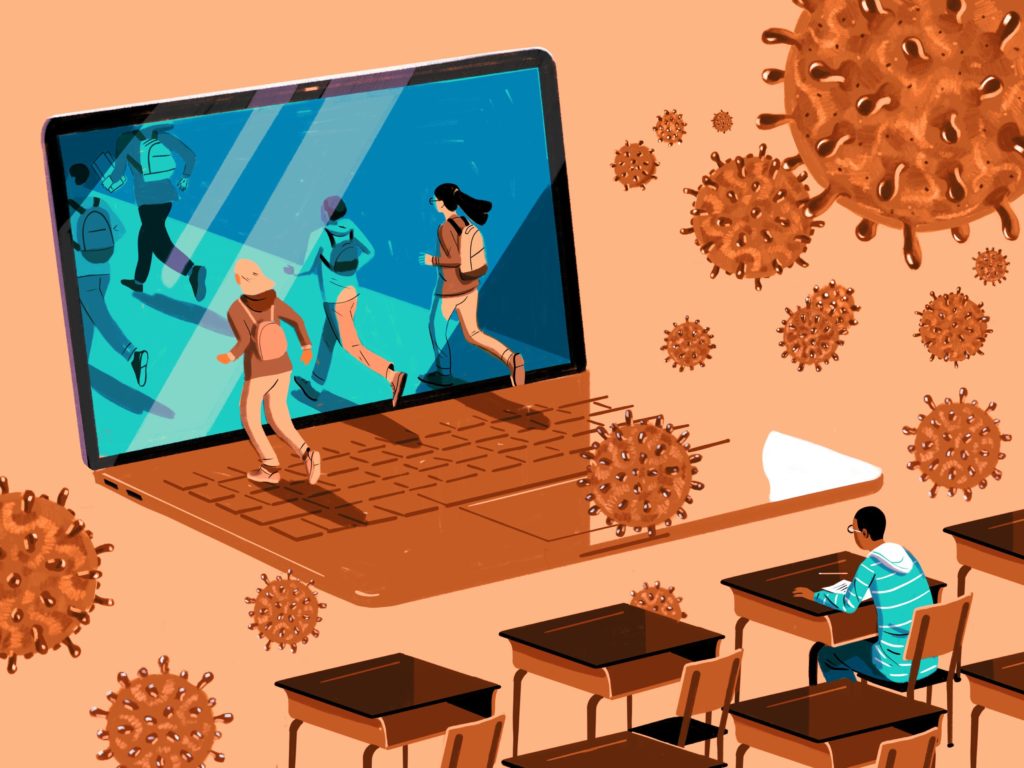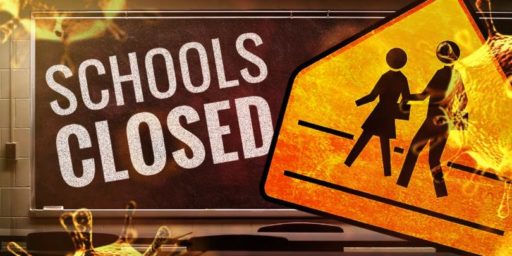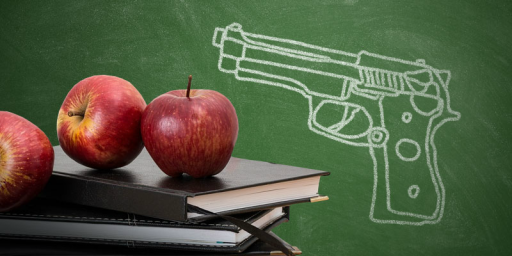Schools, Daycare, and COVID-19
The emotional and economic impact of the pandemic is hitting women especially hard.

A flurry of articles in recent days focus on the stresses, particularly to women, caused by worries schools won’t open and there will be no one to care for children while parents return to work.
First out the gate was NYT columnist Michelle Goldberg with “Remote School Is a Nightmare. Few in Power Care.“
With expanded unemployment benefits set to expire at the end of July, many parents will have no choice but to return to work by September. Even for parents who can work from home, home schooling is often a crushing burden that’s destroying careers, mental health and family relationships. And online school has had dismal results, especially for poor, black and Hispanic students.
Yet the nightmarish withdrawal of the key social support underlying modern parenthood is being presented as a fait accompli, rather than a worst-case scenario that government is mobilizing to prevent. “This school system should be leading the country on figuring out how to bring our kids back,” said [Scott Stringer, the comptroller of New York City[. “And there’s no creativity. There’s no energy behind it.”
This isn’t just a New York City problem. At every level, government is failing kids and parents during the pandemic.
The Centers for Disease Control and Prevention says that if schools reopen, students’ desks should be placed six feet apart, which means far fewer kids in most classrooms. But there’s been no crash program to find or build new classroom space, or to hire more teachers.
Few seem to be exploring the possibility of outdoor classes where weather allows. Experts I spoke to knew of no plans to scale up child care for parents who will need it. Randi Weingarten, president of the American Federation of Teachers, described school districts as “immobilized” by lack of funding.
I’ve been writing about this aspect of the problem for a while now. The teachers are pushing very hard not to go back, for both selfish and understandable reasons. The CDC and the American Academy of Pediatrics are sending out conflicting advice. And parents are caught in the middle.
While most of her column is about these issues, though, her policy bottom line is that Republicans in Congress should back longer unemployment benefits and backstops states and localities who have been crushed by the pandemic. While I tend to agree with her on this, I’m not sure it really solves the problem at hand. Most of us aren’t unemployed and don’t want to give up our jobs to draw benefits; we want schools to be open and safe.
Epidemiologist Jennifer B. Nuzzo and pediatrician Joshua M. Sharfstein weigh in with a plea “We Have to Focus on Opening Schools, Not Bars.”
The way states lifted social distancing restrictions imposed to fight the coronavirus sadly demonstrates our priorities. Officials let bars, restaurants and gyms open, despite warnings from public health experts that these environments pose the greatest risk for spreading the disease.
Yet political leaders seem to have paid scant attention to safely reopening schools.
The consequences of those backward priorities — Covid-19 rampaging through states that reopened quickly — make it even more vital that we extensively prepare to reopen classrooms as safely as possible this fall.
The headline and the opener are a distraction, in my view. It was dumb to open bars and gyms prematurely but they’re simply different problems than opening public schools. One is a matter of removing a restriction on private business owners; the other requires either accepting enormous risk or radically changing how we deliver a vital public service.
Research suggests that the sudden switch to online instruction has cost some students a full year of academic progress. This harm disproportionately affects children in homes without computers and stable internet connections, deepening educational inequality and widening racial and economic divides. The disruption of learning can have lifetime effects on students’ income and health.
The school shutdowns left millions of children without access to meal programs and school-based health services. Reports of child abuse slowed since school employees couldn’t identify and notify the authorities about children they thought were being harmed. And the need for parents to supervise their children on school days or arrange child care has disrupted the economy and made it even harder for many families to get by.
Interestingly, while my local Fairfax County Schools were an absolute disaster in shifting to online instruction, essentially wasting the second half of the spring semester, they were and continue to be near-heroic in their provision of meals. Honestly, I’d have preferred it to be the other way around given their ostensible primary mission.
After several paragraphs arguing the risk of not schooling the kids is much more than the risk of their catching COVID-19, they acknowledge that there is still some risk and schools need to mitigate it. The proposed actions are rather radical:
Increase distance and focus on hygiene. For crowded schools, this could require finding other buildings and space where they could expand.
Some countries in Europe are creating outdoor classrooms to allow for distancing and to take advantage of the reduced risk of transmission in the open air. Tents and other covered structures could be used to create outdoor classrooms in some areas.
Urban school districts may need to lease space. Students and staff members should be checked for symptoms daily and required to wash hands or use hand sanitizer frequently. Masks should be required for all who can wear them, and schools will need extra masks on hand for students and staff members who do not bring their own.
Create in-school “bubbles.” Elementary and middle schools should establish small groups of students who will learn, eat lunch and have recess together. Students and teachers in these groups will interact only with one another. Bubbles may not be feasible in high schools, where students typically move from room to room, so there should be strict requirements for masks, class-size reduction and distances between desks.
Plan for an outbreak. If a coronavirus infection is found, schools should follow Centers for Disease Control and Prevention guidance, which encourages schools to coordinate with local health authorities and to plan to dismiss students and staff members for two to five days.
Refine online instruction. If cases are rising significantly in the area, schools may have to close until that outbreak is under control. They should be prepared by using curriculums that can be rapidly adapted for online instruction.
Allow families and staff members to opt out. Families in households with much older relatives or people with health problems may fear sending their children to school, out of heightened concern that they may bring the virus home. For students in these circumstances, continued remote education should be made available.
Staff members who are older or have chronic medical conditions and who want to be kept out of physical contact with students could teach online classes for those students who remain at home.
Get creative with transportation. It doesn’t make sense to practice distancing in school and then crowd students together for a long bus ride home. School districts should consider car pools and van rides for children in their bubbles. Schools can also increase the number of buses in service and employ staggered start times to transport fewer children at once.
Each of these steps requires resources now. Congress has provided hundreds of billions of dollars of relief for small businesses, but early funding for schools has largely been spent on meals and laptops for remote learning. States should provide funding to school districts in advance of pending legislation in Congress that would provide $915 billion to state and local budgets.
Finally, food blogger Deb Perelman laments that “In the Covid-19 Economy, You Can Have a Kid or a Job. You Can’t Have Both.” She begins by echoing the complaints Goldberg and others have made and wondering why no one is talking about these issues. Obviously, they are. Still, she lays out a compelling case for frustration.
For months, I’ve been muttering about this — in group texts, in secret Facebook groups for moms, in masked encounters when I bump into a parent friend on the street. We all ask one another why we aren’t making more noise. The consensus is that everyone agrees this is a catastrophe, but we are too bone-tired to raise our voices above a groan, let alone scream through a megaphone. Every single person confesses burnout, despair, feeling like they are losing their minds, knowing in their guts that this is untenable.
It should be obvious, but a nonnegotiable precondition of “getting back to normal” is that families need a normal to return to as well. But as soon as you express this, the conversation quickly gets clouded with tangential and irrelevant arguments that would get you kicked off any school debate team.
“But we don’t even know if it’s safe to send kids back to school,” is absolutely correct, but it’s not the central issue here. The sadder flip side — the friend who told me that if their school reopens, her children are going back whether it’s safe or not because she cannot afford to not work — edges closer.
“Why do you want teachers to get sick?” isn’t my agenda either, but it’s hard to imagine that a system in which each child will spend two weeks out of every three being handed off among various caretakers only to reconvene in a classroom, infinitely increasing the number of potential virus-carrying interactions, protects a teacher more than a consistent pod of students week in and out with minimized external interactions.
“You shouldn’t have had kids if you can’t take care of them,” is comically troll-like, but has come up so often, one might wonder if you’re supposed to educate your children at night. Or perhaps you should have been paying for some all-age day care backup that sat empty while kids were at school in case the school you were paying taxes to keep open and that requires, by law, that your child attend abruptly closed for the year.
“Why aren’t you enjoying the extra quality time with your kid?” lays bare what is really simmering below the surface — a retrograde view that maybe one parent (they mean the mom) shouldn’t be working, that doing so is bad for children, that it’s selfish to pursue financial gains (or solvency, as working parents will tell you). It is a sentiment so deeply woven into our cultural psyche that making the reasonable suggestion that one shouldn’t have to abandon a career or livelihood if offices reopen before schools, day cares and camps do is viewed as a chance to redeliberate this.
[…]
I resent articles that view the struggle of working parents this year as an emotional concern. We are not burned out because life is hard this year. We are burned out because we are being rolled over by the wheels of an economy that has bafflingly declared working parents inessential.
After several paragraphs describing the nightmare that she and her friends have been living, she concludes,
Without a doubt, reopening schools is a colossal undertaking. There are no easy solutions to finding enough space for students to socially distance, ensuring teachers and staff are protected, adding more sinks and cleaning staff, and implementing widespread temperature checks, testing and contact tracing.
But after nearly four months since the lockdowns began — four months of working all hours, at remarkable stress levels, while our children have gone without play dates and playgrounds and all of the other stimuli that help them thrive — most parents have been shocked to find that state governments don’t have any creative or even plausible solutions.
For parents who cannot simply sort it out, our national response feels more like a dystopian novel where only the wealthy get to limit their exposure and survive the pandemic unscathed. Allowing workplaces to reopen while schools, camps and day cares remain closed tells a generation of working parents that it’s fine if they lose their jobs, insurance and livelihoods in the process. It’s outrageous, and I fear if we don’t make the loudest amount of noise possible over this, we will be erased from the economy.
Interestingly, government has been a leader on these matters for their own employees. My wife and I bought work for the Defense Department in different parts of its own educational system (me, educating their mid-career officers; she, in educating their children) and we’ve been afforded inordinate flexibility. She has worked entirely from home since mid-March and I’ve only been asked to come in a handful of times.
Still, we’re planning to go to hybrid instruction toward the end of next month. While we’ve delayed the academic year a month, we’re expecting to have in-person classes. We have a four-tier system for faculty, staff, and students with only those in the lowest risk categories expected to be in the classroom. Our third tier is those who are healthy and don’t live with an at-risk person but are otherwise implicated, including the need to stay home with children because schools are closed.
But businesses can’t operate in a similar fashion. Those who provide services need their people on site. And even those who could work remotely need to actually be working, not taking care of their kids. (And that goes for teachers themselves: they can’t very well be teaching others’ kids, whether in person or remotely, and also home-schooling their own.) And I’m skeptical we can operate that way for long: how are professors going to teach synchronous classes while balancing childcare? Something has to give.
There’s no obvious solution for any of this. We could subsidize childcare more generously, as many other advanced societies do. But there’s not an army of caregivers who can swoop in to fill in temporary needs like this. (We see that on a microscopic basis when we have sudden school closures for snow and other weather emergencies.)
Our entire economic structure is built around kids being in school most of the year, with camps and other activities filling the gaps. Maybe that’s a bad idea but I have no alternative.






Great piece James.
In our state they have this notion to do 2 days a week onsite, then home-school the other three days.
It’s a hybrid solution that assures parents can’t have full-time jobs, but also manages to expose the kids to each other (and by extension their entire family) two days a week – thus accomplishing no goals whatsoever, other than assuring full time employment for teachers, janitors, and food service folks.
There is no obvious solution to this. Add in the number of teachers who either have risk factors themselves, or family members at home who are high-risk. Then, add in the *students* who are high risk. Now tell me how we’re going to have teachers ready to teach and students ready to learn while a pandemic for which there is no immediate line of efficacious treatment nor a vaccine, continues to rage.
Florida State University sent a note to all of its work-from-home employees telling them that they no longer will be permitted to care for children while performing WFH duties. How is THAT supposed to work, with daycares still closed and school not in session?
This is an incredibly complex problem with no good solutions. None. I really don’t know how we’re going to adjust for this.
Nice piece James.
All of reasonable solutions to this from a school point of view are expensive. Collectively state and local governments are facing a trillion dollar deficit due to unbudgeted expenses and tax receipt shortfalls. Already budget hawks are talking about slashing school budgets to pay for the deficit. And of course there is little movement in the Senate to assist in ameliorating the deficit problem.
The true solution is universal child care, though that has the same virus related issues that schools have.
Stress reveals weakness in an individual or a system. The weaknesses in the American system which are being revealed by Covid-19 include a lack of a social safety net, and a lack of socialism.
We don’t have decent daycare, we never have because only commies had daycare, good American mommies stayed home and took care of babies. We don’t have a decent social safety net because of our enduring fear that ‘others’ might take advantage of it to avoid work. We have people living on the streets and being fed by food pantries because billionaires need still more billions. And we can’t be bothered to mask up because we are a culture built increasingly on self-pity and pointless belligerence.
We are underperforming every other wealthy country on earth in dealing with Covid-19. Hell, we’re underperforming some poor countries. It’s disgraceful. It’s humiliating. Who is to blame? Oh, this is simple. Who opposes any attempt to improve daycare? Republicans. Who opposes any strengthening of our social safety net? Republicans. Who shovels ever more money into the pockets of the rich and ignores the poor? Republicans.
Who can’t be bothered to mask up because of paranoid fantasies, religious nonsense and the self-pity of white folks? Republicans.
Just about every developed country on earth has a regulated, subsidized system of daycare employing professionals. We have a hodgepodge of poorly-regulated, underfunded, unprofessional operations in church utility rooms and people’s back yards. We have no capacity to even begin now to react to the economic devastation that will flow from our refusal to deal with an issue that has been begging for attention since women started to work outside the home.
Republicans are the pre-existing condition that has left us helpless in the face of a fucking virus.
Additionally, childcare = babysitting, not schooling. Daycare centers are not schools. Daycare and school are two completely different functions.
As I’ve said before, we need to find a way to get kids back in school, not for their parents’ sake but for the kids’. I’m not even talking about socialization here, but their education.
I haven’t had time to read the NYT article you linked to, but I agree with what the headline said. Everyone is focused on opening bars and beauty salons; what about schools? You can drink at home, you can do your own damn nails (I’ve never had a manicure or pedicure in my life), and you can deal with bad hair until it’s time to go back to the office. Having kids fall further and further behind in their education is going to bite us all in the ass years down the road, when these kids lack the education necessary to be productive members of society.
@Nightcrawler:
People are focusing on schools, because they are a difficult problem with a magical solution, distance learning. Distance learning pushes the problem onto parents. @Michael Reynolds: summed the problem up well. Whether it is schools, day care or summer other child care solution, the US doesn’t have a society wide answer and the virus has broken the creaky system.
@Sleeping Dog:
Correction
@Nightcrawler:
This is only true in first-world countries. Doesn’t apply to the US.
One of the long-term pathologies of US governance is that social safety nets have to be disguised or Republicans won’t let you enact them. This is why some of the most important anti-poverty programs we have are administered by the IRS (earned income credit), the Department of Agriculture (food stamps), and local school districts (free or subsidized lunch programs). Republicans want the public schools to provide the babysitting, because that way they can pretend that it’s education, and not welfare. (As if free state-provided education isn’t vastly more socialist than subsidized daycare, but let’s skip that for the moment.) Since Republicans benefit from uneducated masses, this is a twofer for them: they don’t have to vote for new “socialist” daycare programs, and the general quality of public education is held down.
I agree completely that schools should be focused on education and socialization of kids. Anti-poverty programs should be entirely separate, to avoid exactly the nonsense and dysfunction we are seeing right now. Having kids go hungry because the schools are closed makes no more sense than would having water rationing because the schools are closed. But we need to understand why the schools are primarily daycare institutions before we can fix that.
There is probably not one solution. There is going to be a thousand experiments going on. Our school district (in San Antonio, about 60,000 students) is going to a hybrid model. In letters going out this week, parents are going to be asked to choose between in class or remote learning. Switching is allowed but not encouraged but the district acknowledges that circumstances change (like getting a job). Remote learning will be much more structured than it was in the spring. The district also realizes that elementary needs to be a different model than high school.
My wife is a counselor in a low socioeconomic elementary school. I suspect that will be few takers for remote learning.
With the virus out of control here in San Antonio, I really wonder if there is going to be a lot of teachers who will just quit rather than risk getting infected. I’m 66 and I know we will have to take risk mitigation measures everyday she comes home. Basically planning to come through the garage, strip, put clothes in washer and walk into the shower. I’m working from home and probably will be through the fall.
And people are still arguing over masks. So tired of some of these people.
@Michael Reynolds:
I don’t see what they daycare system has to do with this. The problem isn’t that we don’t have daycare; it’s that you *can’t* send children to daycare or even regular school without massive amounts of risk. That would be true no matter what.
(And subsidized daycare isn’t all it’s cracked up to be. The kids in Quebec’s free system famously had worse outcomes.)
@Hal_10000:
THIS. Even if there were an abundance of excellent daycare centers, the virus wouldn’t care. The very fact that daycare establishments had to be shut down the same as public and private schools were demonstrates this. What would it matter if there were ten or a hundred?
@Hal_10000:
And yet all over the developed world kids are going to daycare and their parents are going back to work. Everywhere but here in the home of the brave and land of the free.
With a nationally regulated and paid-for daycare system you can impose mask and glove rules. You have a professional staff capable of carrying out instructions. You can track infection data and react in real time. Your sole toilet facility will not be a single bathroom in an apartment shared by students and a resident family. You’d have cleaning people who can follow procedures for decontamination. You’d have a hierarchy of supervision to go to for answers.
We got none of that. We’ve got random facilities staffed by people with little to no training working for shit money while caring for a class whose size is not limited. Daycare for a lot of people amounts to, “Mom, can you watch your grandchildren for the day?” Because it’s a great idea to get those little disease vectors closed up all day with an elderly person. Or, if you’re really lucky your job has a daycare, which they close when they lay you off, so now you’re delivering Door Dash meals with your kids in the back seat.
This pandemic has done a brilliant job of exposing many of the ongoing problems in this country, including a lack of universal health care and a threadbare social safety net, among other issues…but when we have a president who won’t even model proper social distancing and the issue of wearing masks being politicized, it seems unlikely that we’ll ever develop the collective will to fix those other societal problems, much less combat this pandemic properly…
Shh! Keep it down; they’ll hear you.
On the other hand, they’ll still need places to warehouse their own kids, so maybe they’ll overlook what you said just this once.
@Michael Reynolds:
I don’t know what daycare system you’re talking about because that’s not the one we have (88% of people rate their options as good or excellent). Even if we had an ideal system, you seriously think masks and gloves are going to be enforced on toddlers? The reason daycares are opening in other countries is because those countries got control of the virus and beat it, not because their daycare facilities are better.
And those countries have a much better safety net than we do in this country…I wouldn’t doubt that is one of the reasons why they beat it…of course, part of a better safety net is universal childcare…
I wonder if Americans would still rate their childcare options as good or excellent if they knew the options other countries have? It’s kinda like health insurance….this is what we know. It’s just how it is, here. Options available in other countries are mind-blowing when you get to comparing them.
We’ve home educated our three kids for nearly ten years. One is in college now — well, home from college. The closing of the school system is something we have watched from the outside. It is interesting to see articles like this one — and even more interesting that I have seen so few like this one.
I don’t know how people are going to instant school at home. Home schooling is something that takes intent and planning — not just planning for school but planning how to adjust your entire life to the new system. I have to think people have just had an extended summer vacation — which is not a bad thing, but which can’t continue for years. Online schooling through public systems is notoriously poor — or, at the very least, hit and miss. To have an entire population moving to a home ed program that is known for being the worst home ed option is crazy.
The financial hit is also unimaginable. Obviously, I’m a fan of one parent staying home to teach the kids, it’s what we do. But we are drastically — drastically — poorer than we would have been if we had made other life choices. To expect an entire nation to make that switch involuntarily is ridiculous and, in some ways, very unjust.
I also don’t understand this conversation because “safety” is a concept just being generically thrown out regarding return to school. Whose safety? What kind of safety? The point of closing the schools was not to protect the teachers or the students, it was to avoid having millions of lovely little disease vectors returning home every day to spread COVID among friends, family, neighbors, and fellow grocery shoppers. There are waves of stomach bugs and respiratory illnesses that hit neighborhoods every year about two weeks after school starts, we all know that school spreads disease. Separating desks will do little to change that. Asking six year olds to wear masks all day is a pipe dream, and borderline cruel.
There is little choice here, we have to work public health policy to navigate the epidemic while allowing children to return to school as usual. We need to remember the goal has always been to flatten the curve, not to prevent deaths — because we can’t prevent deaths. We are managing the epidemic, not somehow halting it. Schools will have to reopen, and putting resources into tents or shifting schedules is not the best use of them.
@Mary:
Mary, most of what you said made good sense, but this is just silly. Of course we can prevent deaths. The goal here is not to have the same total number of deaths, spread out over a longer period of time. It is to have significantly fewer total deaths in the end. Some of that reduction comes from not overwhelming the ICUs, but a lot of it comes from simply not exposing large portions of the population to the virus.
In a sensible country, that would happen because we locked down the country for a few weeks while letting the extant infections run their course or get hospitalized. Since we’re not a sensible country, that path is not available.
@DrDaveT: Take the party affiliation out of it and just make it about power structure, and I’d say this is spot on. I’d add that we do not have poverty relief in this country, we have money redistributed to the poor as a accessorizing side effect of shifting it about from one elite entity to another. School lunch programs subsidize the richest as well as the poorest but mainly serve to bolster the jobs program that is the public school system — one to two of every working Americans works for a school. Earned income keeps Americans all reporting in once a year and feeling warm and fuzzy about a government system that has taken far more from them during the year than the supposed welfare is paying; SNAP pays for Pepsi not because the poor need or want Pepsi, it’s a huge subsidy for food manufacturers and retailers. Don’t forget the student loan program, which subsidizes our broken university system and drives up costs for those who want to pay without debt, but the students get the criticism for taking out the loans that they then hand over to others. Same/same for medical, which is paid for either directly by government (government pay for workers and military, Medicaid, Medicare) or by insurance companies who are paid by employers who take money out of workers’ salaries, all because the government got in the business of helping middle men in government bureaus and private industry make money taking their cut.
But none of this is going to change. Our school system is taken as a given, with its accretions accepted as benefits. Even in your own comment, you note that schools should be for socialization — why? Why not have a three to four hour day where the “experts” teach academics because we believe parents can’t, and let children make friends and practice friendship in a healthier environment, a more natural environment? How are teachers necessary for socialization, don’t they just get in the way? You have a paid professional standing in the place of a group of parents, extended family, community members and siblings there voluntarily. You get a room full of kids all exactly the same age and pretty completely with the same socio-economic situation, all chained to desks for seven to eight hours doing what adults tell them to do, with any free choice being within heavily drawn lines, with a couple ten minute breaks in the sun if they are lucky and half an hour to eat food out of a box.
If you want to expand the conversation, it’s turtles all the way down. . . .
@DrDaveT: Hi, Dave,
I can’t see how that is possible. A virus without a vaccine in a connected world will eventually hit just about everyone, it’s just a matter of time. How could it not? Which regularly spread one hasn’t(we leave out the smart viruses that make themselves harder to catch like STIs and the self-destructive ones that kill off their hosts before they can spread themselves widely like Ebola)?
It is certainly the case that I over-simplify in leaving out that people will get worse or no care with an overwhelmed system and so die when they would have lived. But excepting that (which is not nothing, keeping out hospitals uncluttered is pretty much the whole point, except that people leave out that a country swamped with sickness will also see a huge hit to the economy and social and civil structure, defense capability, etc.), how are you not going to eventually see practically every American catch this and die or recover? Am I missing something?
@Nightcrawler: It doesn’t have to be that way — it is actually a real possibility that a conscious system of universal private and home education could do a vastly better job of educating our population than our current system can. We could use this as an opportunity to take a fresh look at all our assumptions. We still have a nation where there are districts where half the graduating seniors — the graduating ones, not the drop outs — are functionally illiterate. Those kids would have done better spending 12+ years sitting in a public library all day. But as things stand, our solution to this stay at home is to have kids do public school, but at home — be under the authority of teachers on Zoom or sending home lists, but the responsibility of parents. Given that, this is a horrible way to educate our young people and can’t go on for more than six months or so without there being huge consequences down the line.
@Sleeping Dog: That’s exactly right.
@DrDaveT: Wait, are you suggesting that if we had initially tracked infection with smart public health protocols and a sharp testing regime and put out the brush fires consistently while there were still only a few thousand infections in the U.S. we could have prevented an epidemic? Well, sure. Would have been great, that should have been the case, it has been the case for other bugs. But that horse is well, well, well out of the barn, no?